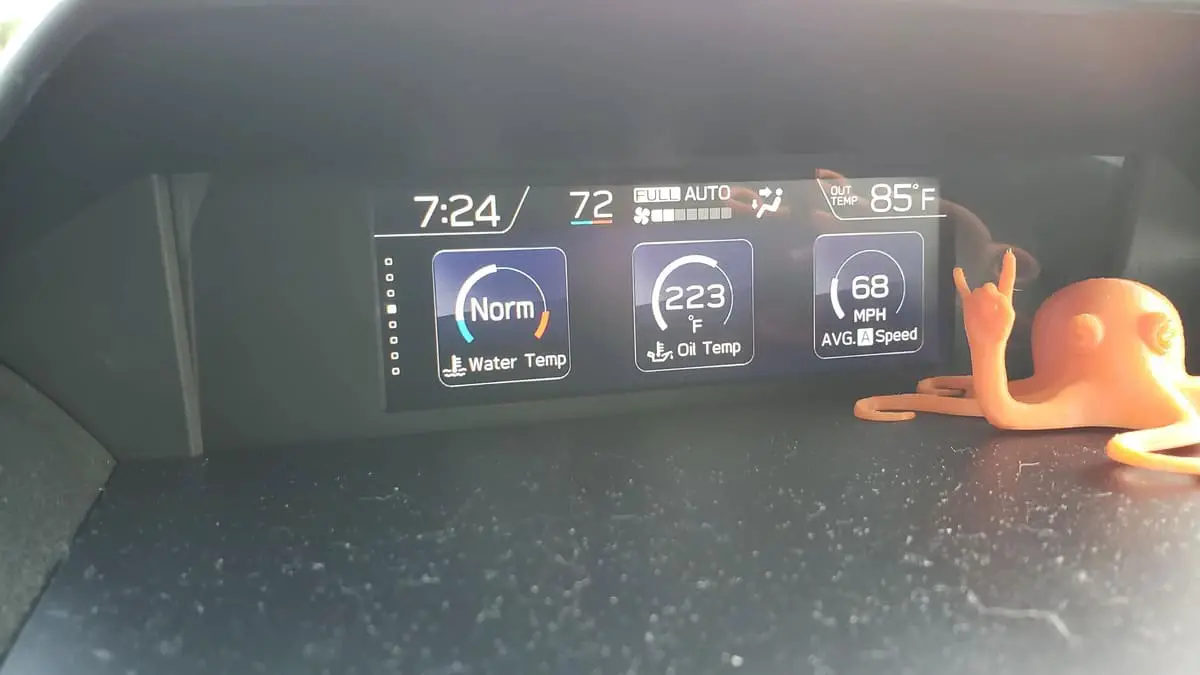At Oil Temp Subaru: Meaning and Fixes for 2024

Driving a Subaru is an enjoyable experience thanks to their renowned handling, safety features, and overall reliability. However, seeing an unfamiliar warning light pop up on the dashboard can give any driver pause. One symbol that may cause concern is Subaru’s oil temperature indicator illuminating.
What does the oil temp light on your Subaru mean, and what should you do when it comes on?
The oil temperature light turning on signals that the engine oil temperature has exceeded its normal operating range, requiring immediate action to prevent potential engine damage.
In this detailed guide, we’ll cover everything you need to know about Subaru’s oil temperature warning light. You’ll learn what causes it to activate, what it means when it turns on, and the steps you should take right away. We’ll also provide tips to help prevent seeing the Subaru oil temp light in the first place through proactive maintenance.
Whether you’ve recently noticed this indicator come on or want to be prepared in case it ever does, this guide has you covered. Let’s get started!
Table of Contents
How Does the Oil Temperature Light Work on a Subaru?
Before jumping into the reasons why Subaru’s oil temperature symbol may illuminate, it helps to understand what this indicator is monitoring in the first place.
The engine oil in your Subaru serves several crucial functions:
- Lubricating the moving components in the engine
- Transferring heat away from the engine itself
- Trapping debris and contaminants
- Preventing metal-on-metal contact between parts
To properly perform all these roles, the oil needs to remain within a normal operating temperature range when the vehicle is running.
Subaru sets this optimal range between 185°F and 225°F. Temperatures outside of this range can begin to compromise the oil’s abilities.
Here’s where the oil temperature warning light comes in. Subaru vehicles have an oil temperature sensor that constantly monitors the current oil temp. If it climbs too high, around 275°F or above, the engine computer will detect this and turn on the oil temperature indicator as a precaution.
This gives the driver an important early warning that the oil is overheating so you can take action before it leads to engine damage.
Now let’s review what causes this important sensor to trigger in the first place.
Top 5 Reasons Subaru’s Oil Temperature Light Turns On
Many Subaru owners first see this warning symbol illuminate because of low oil level in the crankcase. Not having enough oil prevents effective circulation which in turn leads to overheating.
However, there are also other issues that could cause the oil temp to climb and trigger the light:
1. Low Engine Oil Level
As mentioned, low oil level is the most common reason behind the oil temperature warning activating in a Subaru.
The oil level may be low because:
- Oil consumption – Subarus can sometimes burn through more oil and require top-offs between changes.
- Undetected oil leaks – Small leaks over time can lead to lower oil levels. Watch for signs of leaks on your garage floor or driveway.
- Neglected oil changes – Make sure to follow the oil change frequency in your owner’s manual to prevent excessively old oil.
- Failure to check oil level – Be diligent about popping the hood and checking the dipstick at least once per month.
2. Faulty Oil Pump
The oil pump circulates oil throughout the engine to lubricate components and regulate operating temperature. A damaged or failing pump will not be able to maintain proper oil flow.
Oil pump issues usually call for full replacement by a Subaru technician. Until it’s fixed, the oil can easily overheat.
3. Engine Overheating Issues
Engine overheating and oil overheating often go hand-in-hand. As the entire engine heats up, this excessive heat can transfer to the oil as well.
Common causes of engine overheating in a Subaru include:
- Coolant leaks
- Faulty radiator fan
- Blocked air flow through the radiator
- Bad water pump
- Stuck thermostat
- Coolant mix problems
Address any engine overheating problems right away before they impact oil temperature.
4. Engine Sludge Build-Up
Over time, thick sludge can accumulate inside neglected engines. This sludge can clog oil channels, restrict oil flow, and prevent the oil from cooling the engine properly.
To avoid sludge build-up:
- Stick diligently to oil change intervals
- Use high-quality synthetic oils
- Fix any oil leaks allowing contaminants in
- Drive easy when cold to avoid condensation in oil
Removing existing sludge requires a flush service by a Subaru technician.
5. Using the Incorrect Oil Viscosity
Subaru vehicles need oil with the proper thickness or viscosity to work correctly in all climate conditions.
Using oil too thick for cold temperatures makes it harder for the oil to flow and maintain normal temps. Conversely, oil that is too thin can lead to overheating issues in hot weather.
Consult your owner’s manual for Subaru’s recommended oil viscosity grades. For most modern Subarus, this is:
- 0W-20 oil – For temperatures below 0°F
- 5W-30 oil – For average temps from 32°F to 86°F
- 10W-30 oil – For temps consistently above 100°F
Sticking with the manufacturer specifications prevent viscosity-related problems.
Now that you know what causes the Subaru oil temperature warning to turn on, let’s cover what actions you should take right away.
What to Do Immediately When Subaru’s Oil Temp Light Comes On
Seeing the red oil drops or thermometer symbol suddenly illuminate in your Subaru can be stressful. Here are the steps to take right away for safety:
Step 1: Pull Over and Shut Off the Engine ASAP
As soon as you safely can, pull over and turn off the engine. Driving with severely overheated oil can very quickly lead to engine damage. Get it stopped right away.
Step 2: Let the Engine Cool Down
Pop the hood and allow ample time for the engine to completely cool before checking the oil. Hot oil can burn skin and make a mess if spilled.
Step 3: Check the Engine Oil Level
Once cool, check the dipstick to verify oil amount. Top off as needed if the level is low. This may allow you to resume driving normally.
Step 4: Look for Any Visible Oil Leaks
After addressing the oil level, inspect under the car for any noticeable oil leaks that could have contributed to the problem. Watch for leaks near the oil filter, oil pan, valve covers, rear main seal, and related gaskets.
Step 5: Monitor the Dashboard for Other Warning Lights
Keep an eye out for check engine lights or other temperature/mechanical issues indicated on the dashboard display. Multiple warnings may help diagnose additional problems.
Step 6: Contact a Subaru Technician for Diagnosis
If the oil level is normal and no leaks are found, have your vehicle serviced promptly. A technician can diagnose if an oil pump issue, sludge build-up, overheating, or other problem is causing the light to activate.
Properly diagnosing and fixing the underlying cause is essential before continuing to drive the vehicle. Now let’s talk about preventing this light from coming on in the first place.
How to Help Prevent Subaru’s Oil Temperature Warning Light
The best way to avoid the stress of seeing the oil temperature warning illuminate is by staying diligent with routine maintenance. Here are some tips:
- Check oil level regularly – Inspect monthly and top off when needed. Consider adding oil consumption checks between changes.
- Use the manufacturer recommended oil viscosity – Consult your owner’s manual and use the appropriate 0W-20, 5W-30, or 10W-30 oil.
- Follow oil change intervals – Stay on top of scheduled oil changes based on mileage and time intervals. Using synthetic oil can allow longer change intervals.
- Inspect for oil leaks – Watch closely for any signs of leaks from gaskets, seals, filters, and drain plugs. Fix any leaks promptly.
- Service oil and filter – Replace oil and filter based on manufacturer specifications to avoid contaminated oil and sludge build-up.
- Check cooling system health – Flush coolant, replace thermostat, check fans, and service water pump based on recommended intervals to avoid engine overheating.
- Drive gently when cold – Limit hard acceleration and high RPMs until the engine fully warms up to prevent oil and coolant condensation contamination.
Proper oil temperature is crucial for engine longevity. By making oil maintenance a top priority and addressing any problems promptly, you can have peace of mind seeing Subaru’s oil temp warning light stay off for the long run.
Key Takeaways About Subaru’s Oil Temperature Warning
To wrap up, here are the key facts all Subaru owners should know about the oil temperature indicator light:
- Illumination means the oil temperature sensor detects temps exceeding approximately 275°F
- Most likely triggered by low oil level, but can also signal pump issues, sludge build-up, incorrect oil viscosity, and overheating
- Requires immediately pulling over and shutting off engine to prevent potential engine damage
- Check oil level, inspect for leaks, and monitor other dash indicators before resuming driving
- Diagnosis by a Subaru technician is needed to determine and fix the underlying cause
- Sticking diligently to maintenance intervals for oil, coolant, pumps, seals, and gaskets helps avoid activation
Armed with this guidance, you can now act quickly and confidently if the oil temperature light ever comes on in your Subaru. Stay alert on the road and keep up with proactive maintenance. Your vehicle will keep cruising smoothly for the long haul.







